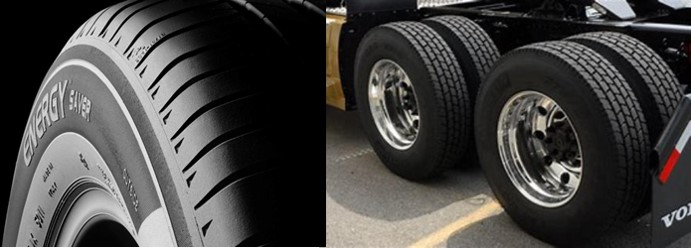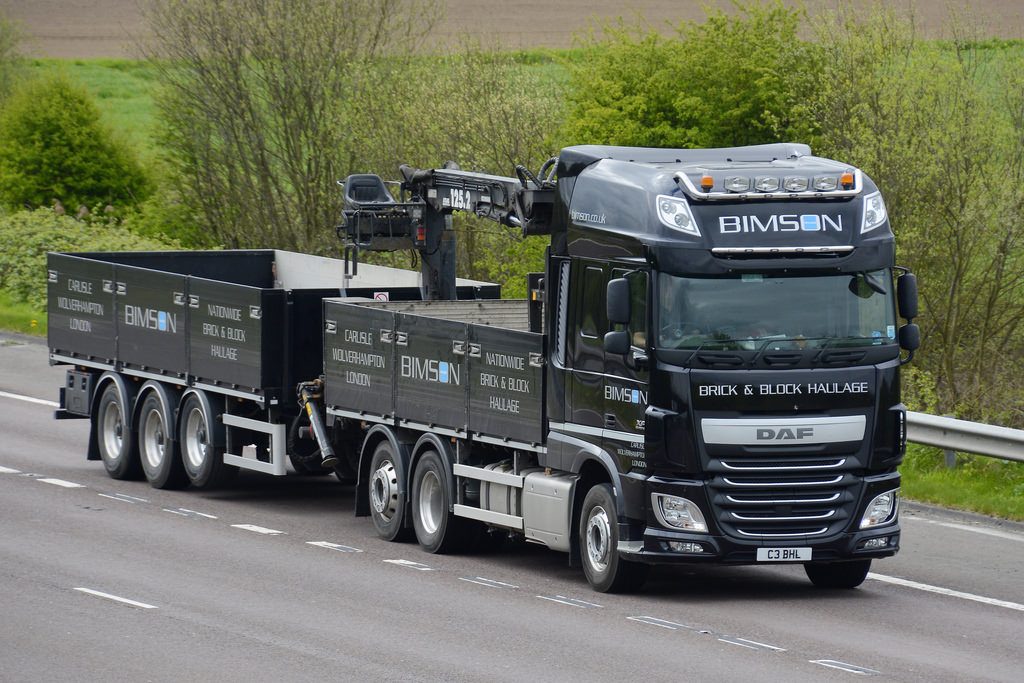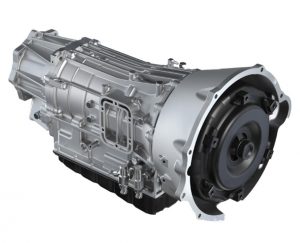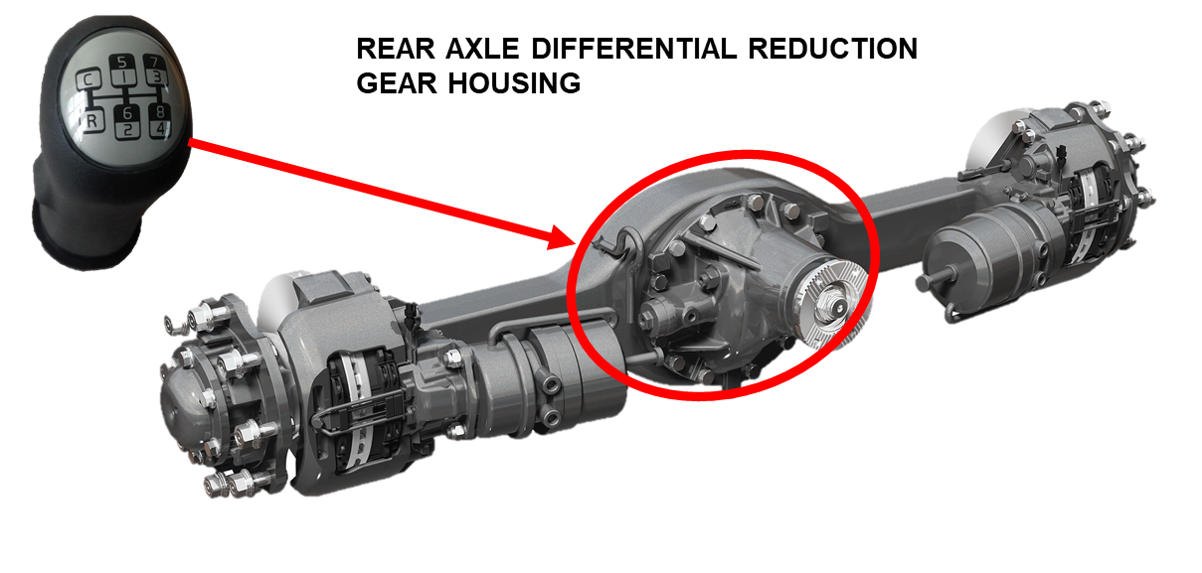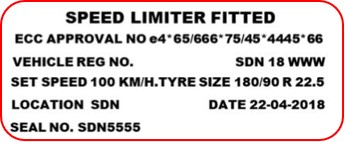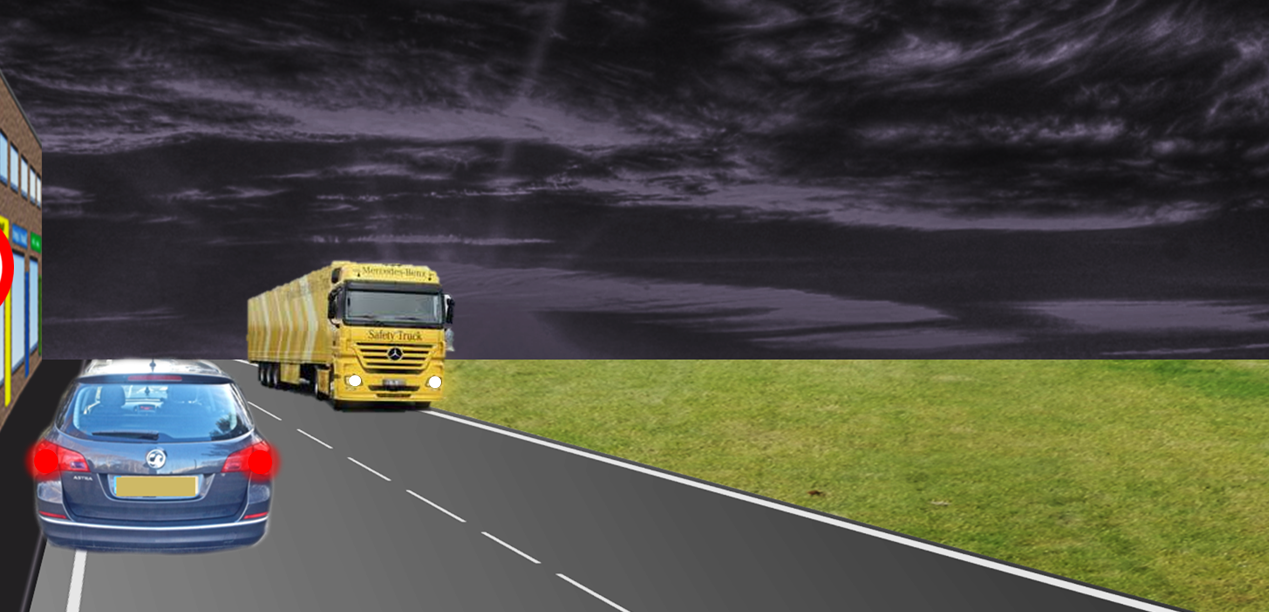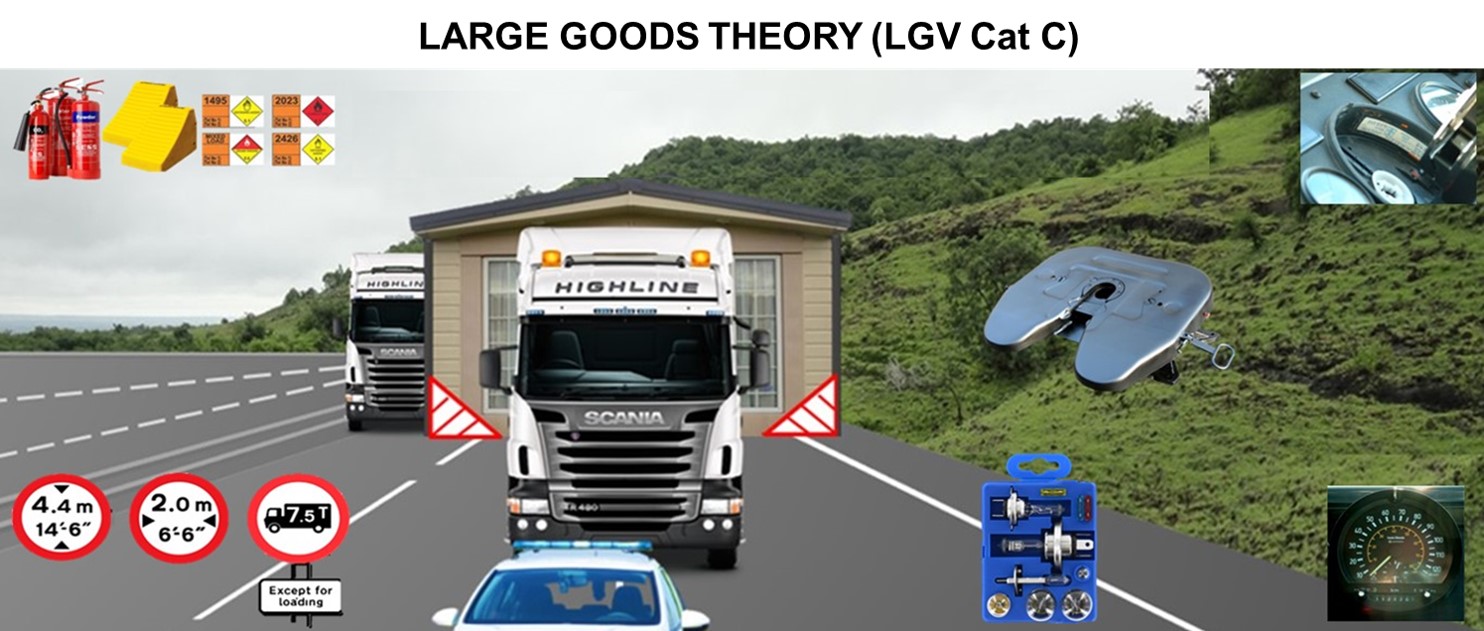VEHICLE CONDITION
Before embarking on any journey you have a legal responsibility to ensure that the vehicle you are driving is fully roadworthy and legal. You must do a daily walk around check. The Vehicle and Operator Services Agency (VOSA) and the police will carry out spot checks on the condition of your vehicle.
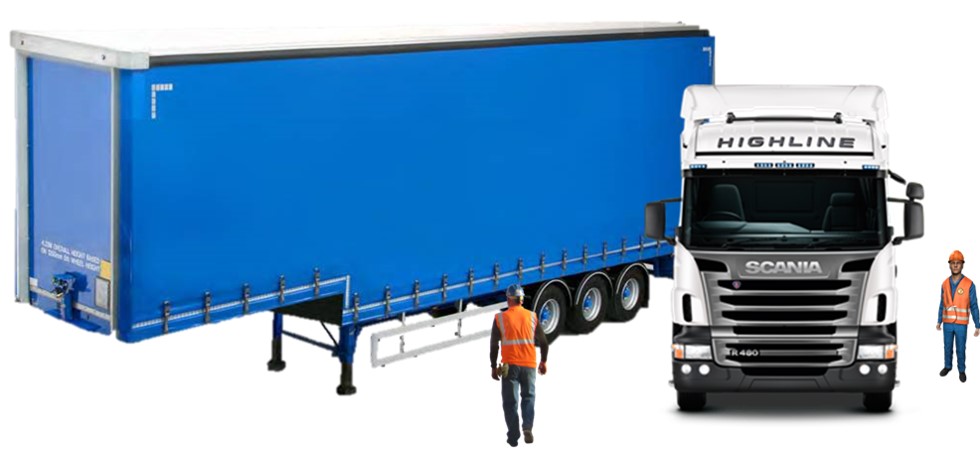 If serious defects are found, the vehicle will be prohibited from further use until these are rectified. The Traffic Commissioner will also be informed of the details. This could result in a heavy fine for both you and your employer. Again, always carry out vehicle checks on a daily basis.
If serious defects are found, the vehicle will be prohibited from further use until these are rectified. The Traffic Commissioner will also be informed of the details. This could result in a heavy fine for both you and your employer. Again, always carry out vehicle checks on a daily basis.
Tyres
When walking around your vehicle make sure that all your tyres comply with the law. The regulations state that there must be a minimum of 1 mm tread depth over 75% (3/4) of the width of the tyre.
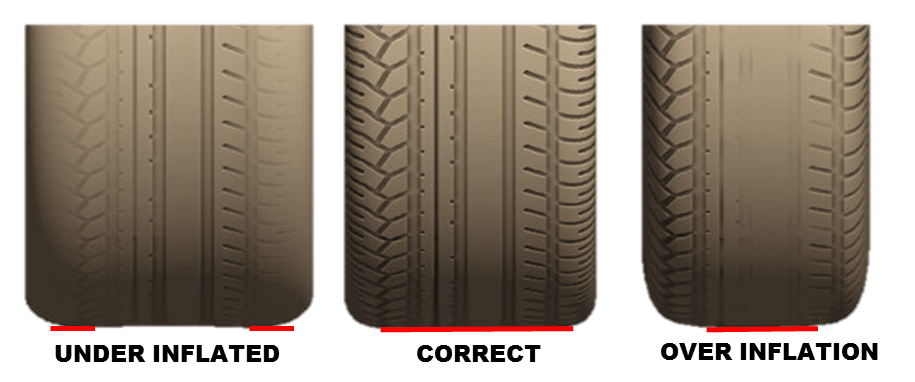 You must make sure that the correct air pressure is held within each tyre and that the general condition of the tyre is good. There must be no ply or chord showing. The tyre is not safe and should not be used if there are any bulges or deep cuts (over 25 mm) in the tyre walls. If these tyres are used they could overheat and burst.
You must make sure that the correct air pressure is held within each tyre and that the general condition of the tyre is good. There must be no ply or chord showing. The tyre is not safe and should not be used if there are any bulges or deep cuts (over 25 mm) in the tyre walls. If these tyres are used they could overheat and burst.
 Power assisted steering can be affected by the tyre pressures. If your tyre pressures are low this can result in the steering being heavy. If you experience a puncture in a front tyre, this will also have the same effect. Stop and seek assistance.
Power assisted steering can be affected by the tyre pressures. If your tyre pressures are low this can result in the steering being heavy. If you experience a puncture in a front tyre, this will also have the same effect. Stop and seek assistance.
There are codes on the side walls of the tyres which refer to the maximum load and speed rating. If you believe that your tyres are not suitable for the weight and load you are carrying consult the vehicle handbook and inform your employer.
If you hit a curb whilst driving, this will not only cause damage to your tyres it can also cause damage to the steering and suspension so it is important that you check these as soon as possible.
As mentioned before the tyre pressures must be correct. Under inflated tyres
will overheat and this could cause a tyre blow-out scattering debris across the
carriageway which will cause danger to other road users.
Tyres that are over inflated will wear unevenly and faster than normal.
If you are driving a heavy load you must increase the pressure for each tyre in line with the recommendations in the vehicle handbook.
When replacing a tubeless tyre do not use the old valve, make sure
that the valve is replaced.
Energy efficient tyres may also be fitted to your LGV. They will help improve the grip, reduce the rolling resistance of the wheel and increasing fuel efficiency.
Some axles have twin wheels. There is a small gap between the two wheels that can trap stones or bricks between them. If you have been on a building site always check for wedged debris before leaving as this can dislodge and be a danger to other road users. The debris can also cause damage to your tyres.
When walking around your vehicle you will need to check that your wheel nuts are secured to the manufacturers recommend torque and that none are missing. If you need to tighten any nut you must use a calibrated torque wrench. Additionally you must check your nuts after an initial replacement of a wheel.
When checking the wheel nuts, you need to check and tighten them diagonally. For safety reasons, if you have to change a wheel you should always use wheel chocks.
As a professional driver, you should carry spare bulbs and fuses in order to replace or fix any fault – not just for your safety but the safety of other road users. You must make sure that your horn and lights are working before each journey.
The flashing of lights and the sounding of your horn are only to be used to warn others of your presence.
You must not sound your horn or any audible reversing device between the hours of 11:30 pm and 07:00 am in a 30 mph or built up area.
In addition to normal lights, trucks also have, along the side of the vehicle, amber lights.
These are called side marker lights. If, during the day, you notice your headlights are not working but you still have working side lights, you still must not drive until they are in full working order as weather conditions can change in an instant.
Coupling and Uncoupling
As the driver of a C+E vehicle, you may find that you need to put a new trailer onto the back of your cab. There is a set procedure for carrying out this. Before connecting, walk around the trailer and make sure that all the tyres, wheels and additional fittings are secure and in a good roadworthy condition.
If you are driving an articulated vehicle, position your cab (tractor unit) in front of the trailer, making sure that it is in line and at the correct height. After checking that the trailer is in a road worthy condition and the trailer parking brake is on, reverse your tractor unit under the trailer. It is very important that you reverse your tractor unit slowly under the trailer until the kingpin of the trailer engages the fifth wheel coupling,
Once locked try to pull forwards, providing the parking break is working on the trailer, you will not be able to move. Make sure that the parking brake of the tractor unit is on, turn the engine off and dismount. Ensure that the kingpin lever is locked completely and insert the dog clip.
Connect the electrical and air lines. Once this has been completed lift the trailer legs up and disengage the parking brake. Before driving off make sure that all the lights are working and that the trailer number plate has been attached.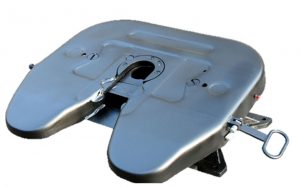
The fifth wheel must be lubricated at regular intervals either monthly or every 10,000 km. The type of grease used for lubricated is known as lithium grease.
Wagon and draw-bar vehicles are also classed as a C+E vehicle. They have a different connection process. For the purpose of the theory, as shown in the picture, you must check for wear and damage to the eyelet coupling.
Most modern day vehicles have a computerised system that will check the engine oil and advise on its level. If you are unfortunate enough to drive an old banger, the oil level must be checked via the dipstick when the engine is cold and on level ground. Over-filling your engine with oil will result in increased pressure. This will damage the gaskets
and cause loss of power.
Due to the workload placed on these vehicles, engine oil should be
changed at recommended intervals. This will reduce friction and wear.
It is also recommended that the oil filter is also replaced as the sediment
collected by the filter could reduce the flow of lubrication and damage your
engine. The oil pump that is used to circulate the oil is driven directly by
the engine.
If your vehicle is fitted with a turbocharger, before switching
your engine off, allow the engine to idle first. This is called the ‘run down procedure’.
Antifreeze
Due to the large capacity of water within the cooling system, it is important to make sure that the correct mix of antifreeze
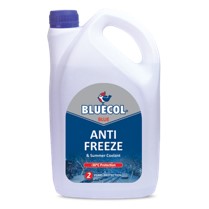 has been added to the cooling system. In order to help protect the engine, this should be done on an annual cycle. The strength of the anti-freeze you use will vary due to the country that you are driving in. You could have to plan a journey to a country with a very cold climate, you will then need to increase the strength in accordance with manufacturers recommendations to prevent freezing.
has been added to the cooling system. In order to help protect the engine, this should be done on an annual cycle. The strength of the anti-freeze you use will vary due to the country that you are driving in. You could have to plan a journey to a country with a very cold climate, you will then need to increase the strength in accordance with manufacturers recommendations to prevent freezing.
Antifreeze can also be added to diesel fuel to help
alleviate the diesel thickening when cold. The additive acts as an anti-waxing agent and does not allow the fuel to solidify. If anti waxing agents are not added, in cold weather, the engine will run erratically.
When diesel becomes hot it expands. Never work on a fuel system unless you are qualified. In addition to anti-waxing agents, there is also a pre-heating device that heats the engine.
AD Blue is a urea based additive that is used with diesel fuel, it is designed to reduce harmful emissions.
For a more detailed explanation and information on how to use AD Blue can be found on line.
ENGINE AND TRANSMISION
There are several questions in the theory test which ask you about the internal combustion engine and its components. The components are as follows: The crankshaft, camshaft, piston and cylinder (I am not sure why this is classed as a working component as it is just a chamber). The high pressure fuel injector delivers fuel to the cylinders and, using poor quality diesel fuel may lead to early blockage of the fuel injectors, increasing the wear of the injector pump.
its components. The components are as follows: The crankshaft, camshaft, piston and cylinder (I am not sure why this is classed as a working component as it is just a chamber). The high pressure fuel injector delivers fuel to the cylinders and, using poor quality diesel fuel may lead to early blockage of the fuel injectors, increasing the wear of the injector pump.
For some strange reason they are now asking you on the theory why it is important to change the cam belt at the right time. If you don’t it can cause damage to the engine.
LGVs have a variety of different gear boxes. Some have selective boxes with high and low ratios. Block changing (missing out gears) can be used when either changing up or down through the gears. Before driving down a steep hill, always make sure that you have changed down to a lower gear.
Modern day vehicles have fully synchromesh gear boxes. In older vehicles these gearboxes were not available and when changing gear you would need to double De-clutch. If your vehicle is fitted with a synchromesh gearbox you must never double De-clutch as this will increase clutch wear.
If your vehicle has an automatic gearbox, before selecting ‘drive’ make sure that your foot is on the foot brake – do not release the foot brake until you are ready to move.
With an automatic gearbox, if you need brisk acceleration, you should depress the accelerator quickly, by doing this the vehicle will change down to a lower gear giving you greater acceleration. This is known as kick-down.
Differential – two speed axle
LGVs, unlike cars, are rear wheel drive vehicles. Power is transmitted through the transmission system from the engine through the gearbox via the prop shaft and differential to the road wheels. The differential allows power to be transmitted through 90 degrees to the road wheels. A two speed axle doubles the number of gears available from your gearbox via a further reduction gear.
The differential also has a lock which is known as the ‘diff lock’. If your vehicle’s nearside wheels are parked on a verge, the transmission system will divert power to the easiest turned wheel. This will cause your wheels to spin, as there is no traction on the wheels on the verge. When the diff lock is engaged this locks power equally to both road wheels, allowing you to move off under control. It is important to disengage the diff-lock once moving. If you do not you will lose control the first time you try to change direction.
TACHOGRAPHS
If your vehicle is fitted with an analogue tachograph you must make sure that the tachograph is legal. In order to comply with the law your tachograph must be calibrated every six years and checked every two years. This must be done at a calibration centre.
There will be a plaque either in the head of the tachograph or near by with the dates of the last check.
SPEED LIMITER
Your vehicle will be fitted with a speed limiter. Even though the maximum speed limit for an LGV (Large goods vehicle) is 60 mph on dual carriageways and motorways, it will be set at 56 mph. This reduced speed can and will have an impact on your vehicle when overtaking.
The speed limiter is an electronic system that when your optimum speed is met it will reduce the fuel supply to the engine. When overtaking it is important to take this into consideration. The speed limiter is a legal requirement and cannot be tampered with. If your speed limiter
malfunctions it must be reported immediately, it can only repaired at an authorised dealer.
ELECTRONIC STABILITY CONTROL SYSTEM
In addition to the safety features that are fitted to your vehicle, the addition of the ESCS (Electronic stability control system) to your vehicle is a benefit. The system senses if the vehicle is about to go into a skid, when this is sensed power is reduced to the road wheels helping you to keep control of your vehicle.
BREAKDOWNS
If your vehicle experiences any fault indicated by a warning light, you must stop and seek assistance. Regular servicing and maintenance will help reduce this problem.
If the ABS lights do not go out on your dashboard shortly after starting the engine and reaching a speed of 6 mph or 10mph, seek assistance.
If the trailer does not have ABS fitted the ABS trailer light will stay on, in this instance this is not a problem.
If you do find yourself with a fault light problem at night on a two way road, try to park on the left hand side of the carriageway, and put your hazard warning lights on.
Although this is a very basic walk around the vehicle in line with the theory test, a more detailed research is needed in the event of taking maintenance on professionally.





